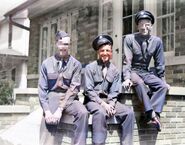Clarence W. Brotherton was a United States Army soldier who went missing in action during the Battle of the Hürtgen Forest on October 14, 1944. His remains were recovered in 1946 and identified in April 23, 2020.
Background[]
Clarence Brotherton was born on September 30, 1924 to Leo and Hannah Brotherton at Gibson City, Illinois. He attended local grade schools at Elliot, Illinois and Gibson City graduated from DTHS.
Military service[]
On July 11, 1943, Brotherton enlisted in the United States Army. By August of 1943, he was stationed at Camp Callan in San Diego, California, and around December 15th, 1943 he moved to Fort Bliss, Texas.
In July of 1944, he was sent overseas and went to fight in the European theatre of Word War II. He was now a Private, First Class, of Company C, 60th Infantry Regiment of the 9th Infantry Division. They travelled through France and Belgium before going into Germany.
The 9th Infantry Division took part in the Battle of Hürtgen Forest. Between September 19 to December 16, 1944, American and German forces fought in a series of fierce battles in and around the Hürtgen Forest of Germany. Company C of the 60th Infantry regiment had to secure the Raffelsbrand Road Junction. On October 13, Brotherton, together with Staff Sergeant Raymond C. Blanton, Private Walter H. Reuter Jr., and Private First Class Leslie E. Shankles attempted to take more pillboxes in the area. They met with a heavy counterattack and were all reported missing in action on October 14, 1944. Due to the ongoing fighting, none of them could be recovered.
The Battle of Hürtgen Forest became a defensive victory for Germany, with 33,000 to 55,000 casualties on the American side and 28,000 casualties on the German side. It was the longest battle on German ground during World War II and is the longest single battle the US Army has fought.
By the time of his death, Brotherton had two other brothers in the Army; Sergeant Lyle in Germany and Sergeant John at Chanute Field, Illinois.
Aftermath[]
After the war's end, the American Graves Registration Service was tasked to identify unknown soldier's remains from the European Theatre. However, they were unable to locate and identify Brotherton's remains. In 1951, the AGRS ruled him unrecoverable. After his death, he was memorialized at the Netherlands American Cemetery and Memorial at Martgraten, Netherlands, the Courts of the Missing at the Honolulu Memorial at Honolulu, Hawaii, and at the Drummer Township Cemetery at Gibson City, Illinois.
In 1946, at least two remains dubbed "X-4491 Neuville" and "X-4492 Neuville" were discovered and comingled from the Raffelsbrand sector of the Hürtgen Forest near Germeter, Germany. In 1951, the remains of eight soldiers were recovered around the area Brotherton went missing. Two were identified as German soldiers and the other six, alongside "X-4491 Neuville" and "X-4492 Neuville," were buried as unknown soldiers at Ardennes American Cemetery in 1950.
Identification[]
A historian working for the Defense POW/MIA Accounting Agency noticed similarities between Brotherton and either "X-4491 Neuville" or "X-4492 Neuville." In September of 2017, the remains were exhumed and transported to the DPAA laboratory at Offutt Air Force Base, Nebraska, for identification. At the lab, scientists from the Armed Forces Medical Examiner System used mitochondrial DNA (mtDNA) analysis and DPAA scientists used dental and anthropological analysis and circumstantial evidence.
Through these methods, the remains were identified as Clarence W. Brotherton on April 23, 2020. The identification was announced on April 27, 2020 and again on August 23, 2021. He was buried on September 7, 2021, at his hometown.

